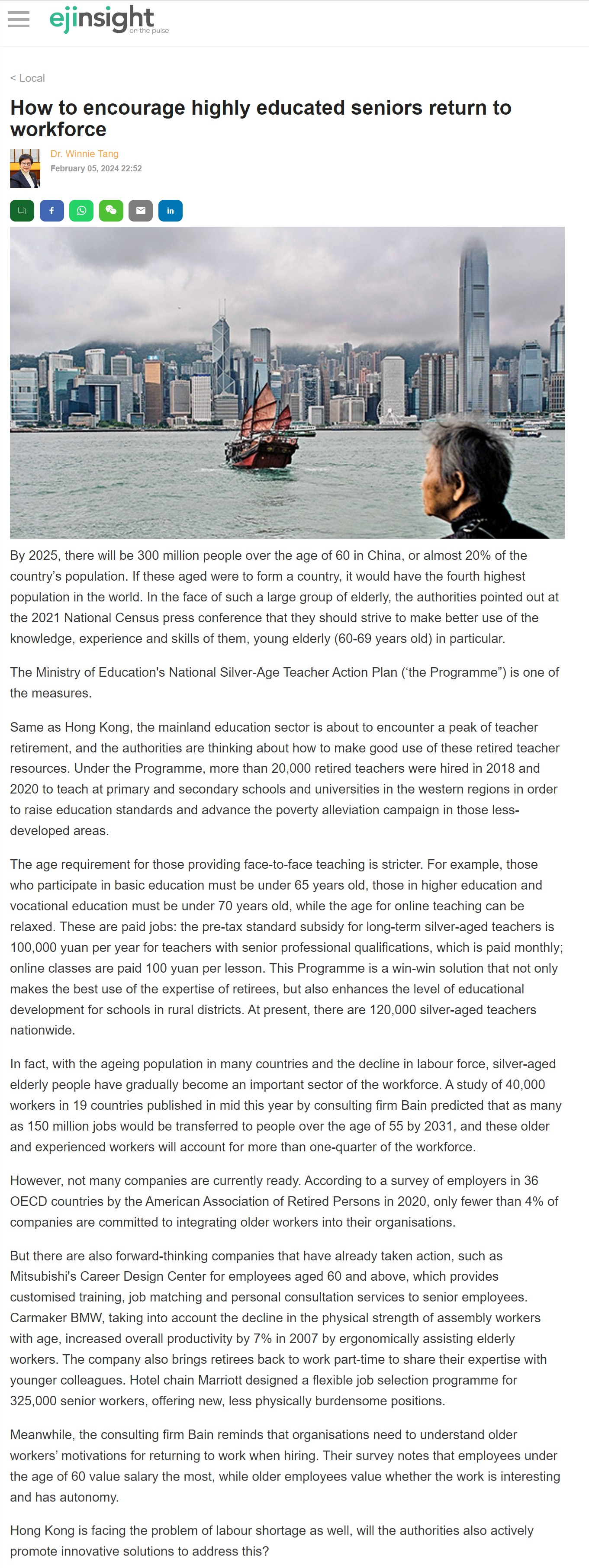網上版請按此

How to encourage highly educated seniors return to workforce
By 2025, there will be 300 million people over the age of 60 in China, or almost 20% of the country's population. If these aged were to form a country, it would have the fourth highest population in the world. In the face of such a large group of elderly, the authorities pointed out at the 2021 National Census press conference that they should strive to make better use of the knowledge, experience and skills of them, young elderly (60-69 years old) in particular.
The Ministry of Education's National Silver-Age Teacher Action Plan ("the Programme") is one of the measures.
Same as Hong Kong, the mainland education sector is about to encounter a peak of teacher retirement, and the authorities are thinking about how to make good use of these retired teacher resources. Under the Programme, more than 20,000 retired teachers were hired in 2018 and 2020 to teach at primary and secondary schools and universities in the western regions in order to raise education standards and advance the poverty alleviation campaign in those less-developed areas.
The age requirement for those providing face-to-face teaching is stricter. For example, those who participate in basic education must be under 65 years old, those in higher education and vocational education must be under 70 years old, while the age for online teaching can be relaxed. These are paid jobs: the pre-tax standard subsidy for long-term silver-aged teachers is 100,000 yuan per year for teachers with senior professional qualifications, which is paid monthly; online classes are paid 100 yuan per lesson. This Programme is a win-win solution that not only makes the best use of the expertise of retirees, but also enhances the level of educational development for schools in rural districts. At present, there are 120,000 silver-aged teachers nationwide.
In fact, with the ageing population in many countries and the decline in labour force, silver-aged elderly people have gradually become an important sector of the workforce. A study of 40,000 workers in 19 countries published in mid this year by consulting firm Bain predicted that as many as 150 million jobs would be transferred to people over the age of 55 by 2031, and these older and experienced workers will account for more than one-quarter of the workforce.
However, not many companies are currently ready. According to a survey of employers in 36 OECD countries by the American Association of Retired Persons in 2020, only fewer than 4% of companies are committed to integrating older workers into their organisations.
But there are also forward-thinking companies that have already taken action, such as Mitsubishi's Career Design Center for employees aged 60 and above, which provides customised training, job matching and personal consultation services to senior employees. Carmaker BMW, taking into account the decline in the physical strength of assembly workers with age, increased overall productivity by 7% in 2007 by ergonomically assisting elderly workers. The company also brings retirees back to work part-time to share their expertise with younger colleagues. Hotel chain Marriott designed a flexible job selection programme for 325,000 senior workers, offering new, less physically burdensome positions.
Meanwhile, the consulting firm Bain reminds that organisations need to understand older workers' motivations for returning to work when hiring. Their survey notes that employees under the age of 60 value salary the most, while older employees value whether the work is interesting and has autonomy.
Hong Kong is facing the problem of labour shortage as well, will the authorities also actively promote innovative solutions to address this?
Dr. Winnie Tang
Adjunct Professor, Department of Computer Science, Faculty of Engineering; Department of Geography, Faculty of Social Sciences; and Faculty of Architecture, The University of Hong Kong